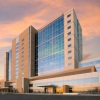DOTmed Industry Sector Report: Bone Densitometers Sales and Service
by Barbara Kram, Editor | August 26, 2008
"We do still support our DPX product portfolio in terms of service, but we do recommend our customers start looking into newer technologies because at some point, it will 'end of life,'" said GE's Andreasen, referring to the service phaseout process. "DPX is one of the older technologies and as we introduce newer and better technology, we try to 'end of life' some of the old products. Otherwise we end up having 15 to 20 products and that is just not good business for anybody."
Hologic, with an installed base of more than 15,000 bone densitometry systems worldwide, is also focusing on the future with its fan beam technology. "We no longer sell any pencil beam products. We felt the future was completely in fan
beam because we can get very good images [and] the fastest throughput," Jenkins said.
We repair MRI Coils, RF amplifiers, Gradient Amplifiers and Injectors.
MIT labs, experts in Multi-Vendor component level repair of: MRI Coils, RF amplifiers, Gradient Amplifiers Contrast Media Injectors. System repairs, sub-assembly repairs, component level repairs, refurbish/calibrate. info@mitlabsusa.com/+1 (305) 470-8013

When one door closes, another opens and refurbishers and independent service organizations are poised to maintain and repair older machines coming off OEM service contracts. So while sales have slowed, service opportunities abound in
the aftermarket.
"In 2005, we put in a table every 10 days. Now it's every 15 to 20 days. Sales are off 30 percent," said Desmond Johnson, Service Manager, DEXAScanners, Inc., Lebanon, TN. "A huge number of pre-owned units are on the market and prices
have dropped accordingly. But service has blossomed so revenues are the same."
"It's great for us because we've got literally tens of thousands of parts stocked for these machines. So when the manufacturers stop supporting them, that is when we can support those customers that don't want to upgrade because they don't need to and the machines are working great and are reliable," Denholtz said.
Other players in the market
Smaller OEMs are also a factor in bone density testing, among them Norland, Sunlight, and Schick.
Alara, Inc.'s MetriScan® uses a simple, affordable design for screening patients. Technically, it's not a DEXA scanner because the MetriScan uses digital radiographic absorptiometry of the hand. (DEXA or DXA stands for dual-energy X-ray absorptiometry.) The MetriScan brings bone density screening









